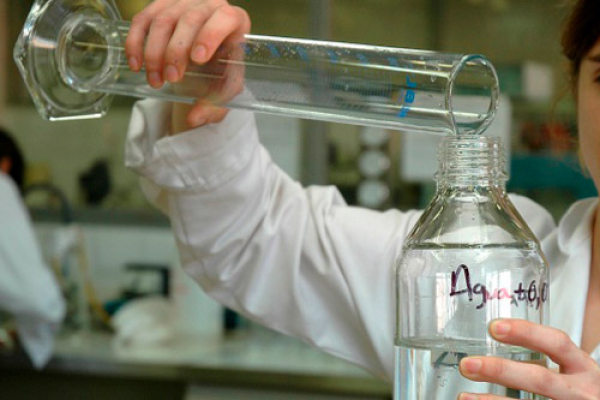UAH studies new antiviral strategies against COVID-19
UAH Patronage Plan funds various research projects in relation to COVID-19. Among these are the BIONANODEN group, led by professors Rafael Gómez and Francisco Javier de la Mata, together with Paula Ortega and Angela Martín-Serrano, and MOABAC, led by Antonio Jiménez.
Both groups work together to look for new antiviral drugs to deal with this new coronavirus. In addition, this search is linked to the experience of other researchers such as the group of aptomers of IRYCIS, the group of the University of Napoles, led by Dr. Galdiero, and the group of CISA-INIA, led by Dr. Sevilla.
- What is the purpose of this research?
The objective of this project is to develop new drugs that can be active against the SARS-CoV-2 virus and prevent the development of COVID-19 disease.
There are currently two very promising strategies that use biological polymers to fight viral infections. On one hand, there are antiviral peptides, which to date have been shown to be effective against viruses such as HIV or the flu. On the other hand, aptomers, also called chemical antibodies, are single-stranded RNA or DNA molecules formed by 20-80 nucleotides capable of binding specifically and with high affinity to a molecule of interest, thanks to their unique three-dimensional structure. However, both antiviral and aptamers are strange to our body, which will struggle to degrade or expel them. It is therefore necessary to establish management systems that allow them to remain intact in the body for the time required to perform their function.
To solve this problem, we will use nanotechnology. More specifically, carbosilane-type dendrimers with sulfonate (negative charge) groups on the surface that will act as nanotransporters, increasing the solubility and bioavailability of antiviral peptides and aptamers. In addition, they are expected to provide additional antiviral capacity, as they have been shown to be effective against other viruses such as HIV or Herpesviruses.
- How can antivirals help to control the virus?
It is important to know that viral infection is established through complex interactions between the virus and the host's cell system, which in this case would be humans, of which viruses are dependent in order to survive, replicate and re-infect.
Research on SARS-CoV-2 shows that the virus interacts with the host cell using a protein called the Spike protein (S). That protein is able to anchor to the ACE2 prescribers of the cell to infect, mediating the entry of the virus and the fusion process between the viral envelope and the membrane of the host cell.

- What makes these antiviral drugs you are investigating different from those already on the market?
When designing an antiviral, it is done with the parts that make up the virus to which they are targeted, their way of interacting with the host cell to be able to infect it, and what part of its structure is responsible for ‘attack’ on our cells.
In this case, it is intended to design both antiviral and aptomer peptides capable of interfering with the virus binding to the cell membrane by causing the S protein in the cell membrane to bind to the systems designed rather than to its cell receptor. This would allow to block the entry of the virus, which would thus lose its infection capacity.
- How long do you think they will have definitive results?
It is difficult to be able to date, as this project is based on basic research which, later, if the results were satisfactory as we hope, would move from one in vitro approach to another in vivo, which is usually a complicated process.
Still, we hope to have the first dendrytic systems that will act as nanotransporters of peptides and aptomers within about 4-6 months and then start with the in vitro measurements of the antiviral capacity of the systems and within a year, we´ll have the first results.
To stop the pandemic, will it be necessary to have a vaccine or specific antiviral drugs like those you are studying?
As the popular sailer says ‘Prevention is better than cure’, so the vaccine, being a prevention treatment, is the best option. Vaccines prevent the disease from being acquired, help achieve group immunity, and can lead in the eradication of the disease.
The most representative example of the effectiveness of vaccines is the fact that this year has been celebrated the 40th anniversary of the eradication of smallpox, a disease that threatened humanity for 3000 years. Only during the twentieth century caused 300 million people deaths. Developing a vaccine is not an easy task. First, good results must be achieved in animals and then their effectiveness and safety must be demonstrated in a large number of people in order to be finally used over large segments of the population.
The vaccine also has to be able to maintain the immunity of the vaccinated person for a long period of time. Moreover, it must be able to be produced on a large scale and be cheap, to do vaccination possible even in countries with fewer resources. Achieving these results requires strong international cooperation, solidarity and scientific effort.
Research on antiviral treatments is also deeply laborious, but not less important. Until we have vaccines for SARS-COV-2, it´s essential to find treatments that prevent infection or improve the chances of recovery of infected patients.
Other scientific aspects of deep interest are, for example, improvements in early diagnosis of the disease or understanding why the virus is deadly to some people while others develop the infection without being aware of it. It is also important that there is good communication and that we know what does not work to keep moving forward.
Finally, all the scientific knowledge derived from SARS-Cov-2 research will contribute in the struggle against the pandemic.
Publicado en: Inglés
